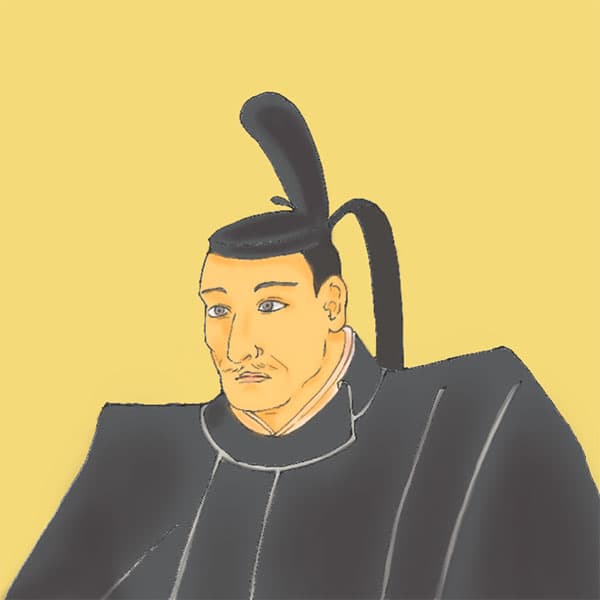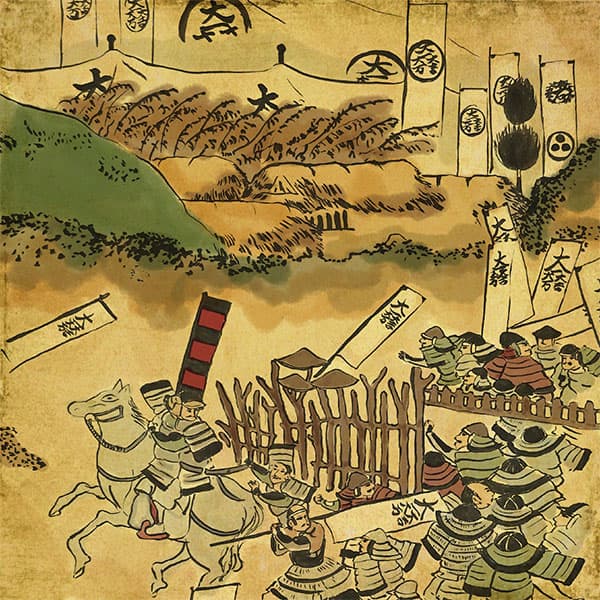Tadayoshi Matsudaira (1/2)The daimyo who started the fire at Sekigahara

Tadayoshi Matsudaira
- Article category
- biography
- name
- Matsudaira Tadayoshi (1580-1607)
- place of birth
- Shizuoka Prefecture
- Related castles, temples and shrines

Oshijo

Kiyosu Castle
- related incident
In the late Muromachi period, the period of war, also known as the Sengoku period, ended with the Tokugawa clan. The battle that brought an end to this era was the Battle of Sekigahara. In this battle, more than 100,000 people faced each other in east and west, and Tadayoshi Matsudaira fired the first shot. Tadayoshi was born in Hamamatsu as the fourth son of Tokugawa Ieyasu, who later became a ruler of Japan, and became the lord of Kiyosu Castle in Owari Province. This time, I would like to take a look at what kind of person Matsudaira Tadayoshi was.
Birth of Tadayoshi Matsudaira
Tadayoshi Matsudaira was born in Hamamatsu, Totomi Province (currently Hamamatsu City, Shizuoka Prefecture) in 1580 as the fourth son of Tokugawa Ieyasu, a daimyo in Mikawa Province. His childhood name was Fukumatsumaru, his mother was Oi no Kata (Tsune Saigo), and he was the same mother's brother as Hidetada Tokugawa, the second shogun of the Edo shogunate.
This was in 1581, the year after Tadayoshi was born. Matsudaira Ietada, head of the Tojo Matsudaira family, a member of the Tokugawa family, died of illness.
The Tojo Matsudaira family was founded by Yoshiharu Matsudaira, the third son of Nagachika Matsudaira, the grandfather of Ieyasu Tokugawa's grandfather Kiyoyasu Matsudaira (great-great-grandfather from Ieyasu Tokugawa's point of view).
They came to be called the Tojo Matsudaira family because their residence was Tojo Castle in Tojo, Yokosuka Village, Hazu District, Mikawa Province (present-day Kira Town, Nishio City, Aichi Prefecture). Yoshiharu Matsudaira, the founder of the Tojo Matsudaira family, was a member of a family that made great achievements by supporting Tokugawa Ieyasu's grandfather Kiyoyasu and father Hirotada through difficult times.
Therefore, his father, Ieyasu, ordered Tadayoshi to take over the headship of the Tojo Matsudaira family, which had no head. Shortly after his birth, Tadayoshi began to own 10,000 koku of Mikawa Tojo Castle.
The following year, in the 10th year of Tensho (1582), the Takeda clan of Kai was attacked and destroyed by the Oda and Tokugawa clans, and Tadayoshi moved from Tojo, Mikawa Province to his new territory, Suruga-Numazu Castle (present-day Numazu City, Shizuoka Prefecture). It will be resealed.
Kanto relocation and Oshijo
Matsudaira Tadayoshi's father, Tokugawa Ieyasu, followed Toyotomi Hideyoshi after Oda Nobunaga died in the Honnoji Incident.
Toyotomi Hideyoshi subjugated the Hojo family in the Kanto region (Odawara Conquest) in 1590.
Tokugawa Ieyasu invaded the Kanto region as a subordinate of Hideyoshi, but after the Hojo family surrendered, he was confiscated of the Tokai region, which had been their territory until then, and given the former territory of the Hojo family.
Specifically, Mikawa Province (present-day eastern Aichi Prefecture), Suruga Province, Totomi Province (present-day Shizuoka Prefecture), Kai Province (present-day Yamanashi Prefecture), and Shinano Province (present-day Nagano Prefecture) 1.5 million countries were taken over. He was given 2.5 million koku for the entire Kanto region: Musashi Province, Izu Province, Sagami Province, Ueno Province, Kazusa Province, Shimousa Province, part of Shimotsuke Province, and part of Hitachi Province.
Matsudaira Tadayoshi was given 100,000 koku by the lord of Oshi Castle in Saitama District, Musashi Province from Numazu Castle in Suruga Province in 1592 due to Ieyasu's transfer to the Kanto region.
Oshi Castle was the residence of the Narita clan, which belonged to the Hojo family, but during the conquest of Odawara, it withstood the attack of the Toyotomi army, led by Nagachika Narita, who was a member of the Narita clan, and Mitsunari Ishida. It was the only castle that was protected to the end.
After that, the Narita clan was divided into those who followed the head of the family, Ujinaga Narita, who became an independent daimyo, those who served the newly appointed feudal lord Tadayoshi Matsudaira, and those who quit being samurai and engaged in agriculture. Narita Nagachika's son, who successfully defended the castle during the siege, entered the service of Matsudaira Tadayoshi, and Nagachika followed his son to live in Owari Province in later years. In this way, Tadayoshi Matsudaira, who became the lord of Oshi Castle, grew up and celebrated his New Year's Festival.
First Battle of Sekigahara
In 1593, Tadayoshi Matsudaira got married. His opponent was Masako, the daughter of Naomasa Ii, one of the Four Heavenly Kings of Tokugawa and the lord of the Minowa clan in Ueno Province, who owned 120,000 koku. In this way, Tadayoshi celebrated his New Year's festival as the lord of Oshi Castle and got married, but there was a political change in his father, Tokugawa Ieyasu.
In 1598, Toyotomi Hideyoshi, to whom Ieyasu belonged, died.
After Hideyoshi's death, conflicts intensified between Ieyasu, who took the lead, and groups such as Ishida Mitsunari who opposed him.
In 1600, Kagekatsu Uesugi was suspected of rebellion, and a subjugation force led by Ieyasu headed east. At this time, Matsudaira Tadayoshi led an army for the first time.
Around the time Ieyasu and his friends arrived in the Kanto region, Ishida Mitsunari raised an army at Osaka Castle.
Ieyasu led his army, with Tadayoshi as its commander-in-chief, and led it up the Tokaido route, centering on Toyotomi's vassals. Afterwards, Ieyasu himself went up the Tokaido road and confronted Mitsunari Ishida at Sekigahara.
On the day of the Battle of Sekigahara, Masanori Fukushima was supposed to be in the vanguard that day, but his father-in-law, Naomasa Ii, took Tadayoshi out on a reconnaissance mission. One theory is that Naomasa, who understood Ieyasu's wishes, tried to sneak out of the vanguard in order to let Tadayoshi, who was in his first battle, take credit.
On the way, he was attacked by Kani Saizo of the Fukushima clan, but when he escaped and reached Sekigahara, he fired a gun at him. Thus began the Battle of Sekigahara, one of the largest battles in Japan.
Tadayoshi takes credit for his first battle by starting the battle of Sekigahara.
By mid-afternoon, the eastern army led by Ieyasu had gained the upper hand, and the western army, which belonged to Ishida Mitsunari, pursued the battle.
Naomasa Ii and Tadayoshi Matsudaira, who were chasing the Shimazu family as they fled from the battlefield, had their way blocked by Toyohisa Shimazu. Tadayoshi received a wound in the head, and Naomasa Ii was also shot in the leg with a gun and fell from his horse, but they defeated Toyohisa, making their first battle. Despite this, he achieved great success.
Transferred to the Seishu domain
Matsudaira Tadayoshi, who was recognized for his achievements in the Battle of Sekigahara, followed Masanori Fukushima, who was transferred to Aki-Hiroshima and Bingotomo (present-day Hiroshima Prefecture), to Kiyosu, Owari Province (present-day western Aichi Prefecture) and Mino. He was given 520,000 koku from the country (present-day Gifu Prefecture) and moved from Oshijo.
Although Tadayoshi showed great bravery in the Battle of Sekigahara, when he moved to Kiyosu he also tried to acquire knowledge. Nakataka Shimotsuma, who was once a monk at Honganji Temple and belonged to Nishi Honganji Temple after the Battle of Sekigahara, was an expert in Sarugaku, and Nakataka wrote the secret book of Sarugaku called Dobu-sho. I am aiming to excel in both literature and martial arts, such as receiving a degree.
In terms of rank in the Imperial Court, he was promoted to Jusanmi (Jusanmi Sakonoe Lieutenant General) in 1605, and then to Satsuma Province in the following year (1606), and was steadily gaining official positions.
However, perhaps as a result of the injury he received at the Battle of Sekigahara, he gradually began to fall ill in 1604.
The end of Tadayoshi Matsudaira
Matsudaira Tadayoshi became the lord of Kiyosu Castle in Owari Province, but in 1604 he fell ill. So, in order to fight the disease, I went to Tajima Province to take a hot spring treatment.
In 1605, he suffered from a tumor and was in critical condition for a time, but was revived with medication.
However, he was unable to recover from his illness, and in 1606, he frequently sought medical treatment, such as going to Chita District, Owari Province, to visit hot springs.
- related incident

- WriterTomoyo Hazuki(Writer)I have loved history and geography since my student days, and have enjoyed visiting historical sites, temples and shrines, and researching ancient documents. He is especially strong in medieval Japanese history and European history in world history, and has read a wide range of things, including primary sources and historical entertainment novels. There are so many favorite military commanders and castles that I can't name them, but I especially like Hisashi Matsunaga and Mitsuhide Akechi, and when it comes to castles, I like Hikone Castle and Fushimi Castle. Once you start talking about the lives of warlords and the history of castles, there's a side of you that can't stop talking about them.





